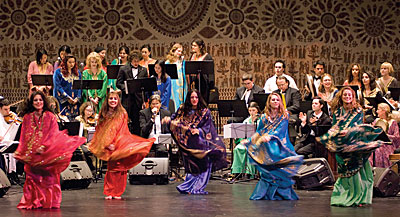Anna Asatourian
Writer
War. Political instability. Fear. These are all words commonly associated with the Middle East, but have you ever stopped to ask yourself why? How different are we from this foreign concept that we sum up as, “The Middle East”?
On November 20th, the UCSB Middle East Ensemble, coordinated by Alexandra King, Cris Basimah, Susan Rudnicki, and Dr. Scott Marcus, gave a phenomenal performance at Lotte Lehmann Concert Hall.
Dr. Marcus’ thoughtful commentary regarding the brilliant live music and dances performed on stage shone light on the Middle East as a richly cultural and diverse people whose artistic and traditional values are too often overlooked.
In July 2010, the UCSB Middle East Ensemble was invited by the Egyptian Government to perform at the Cairo Opera House and in several cities, including Ismailia, Helwan, and Beni Suef.
“The people of the Middle East like to sing and dance like us. They are not a monolithic political whole, ” said Percussion Director Susan Rudnicki.
At Lotte Lehmann Hall, the Ensemble performed musical and dance pieces from different parts of the Middle East, exemplifying the cultural diversity of this region.
“Sama’i Rast” was composed by an Armenian musician in the 20th Century, andTahmilah Suznak is an Arabic genre of music in which performers take solos. Giselle Garcia sang “Ahu Da Ili Sar”, an Egyptian nationalist song, in a traditional Middle-Eastern sequined white dress. A recent UCSB graduate, she stunned the house with her powerful voice.
Garcia spoke about the significance of the Ensemble’s trip to Egypt and how it put the Middle East in a completely new perspective.
“They [Egyptians] were very surprised at Americans, and loved that we sang in Arabic, ” she said.
Garcia also mentioned how Americans do not have the best reputation among Middle Easterners, and that the Ensemble was able to eradicate that view by interacting with the Egyptians and showing its appreciation for the culture.
“We showed the Egyptians that we enjoy Middle Eastern music, and that we are more alike as people than we are different,” said Rudnucki.
The concert continued with Dr. Bahram Osqueezadeh’s santur solo and two Persian folk songs that were derived from different regions of Iran. These songs were entitled “Hey Yar, Hey Yar “(Oh my love, Oh my love), which is a secular love song and “Ya Mowla”, a sacred song.
Following this number was a Dabka dance to a song called “it-Tannura” (The Skirt). This performance was done to a song by a recent Lebanese singer which tells a lighthearted story of a girl who continues to draw attention by shortening her skirt. The Dabka dance to “it-Tannura” illustrates that flirtatiousness and celebration exist, even in what we picture as the most conservative of societies.
“Middle Eastern cultures value what we value. They sing and dance about their beloveds and nationalistic views,” said Rudnucki.
A dazzling solo belly-dance finale was performed by Alexandra King to conclude the show.
The UCSB Middle East Ensemble puts forth a performance that is artfully prepared, authentic, and educational. The concert challenged the predispositions about the Middle East and opened up a new way of looking at this region.
The next concert dates for the Middle East Ensemble are March 5, 2011 and May 21, 2011.

















